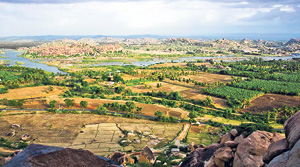“If a dream were made out of rock,” we were told, “it would be Hampi.” And truly, Hampi inspires dreaming: cool halls of stone still seem to echo with a thousand footfalls, musical pillars still ring true, and in the immense temples offerings are still made to the old gods. The sprawling UNESCO World Heritage Site is widely considered one of India’s greatest archaeological treasures, and most intriguing of all – the world’s largest open-air museum.
Located in the South Indian state of Karnataka, the gorgeous ruins of the Imperial Capital of the ancient Vijayanagara Kingdom stretch for over 28 square km along the Tungabhadra River. It is from an anglicized version of the river’s ancient name – Pampa – that the city is named.
 |
| Temple |
Like Petra or Delphi, the appeal of Hampi is timeless. For some its magic lies in the stark beauty of the many thousands of boulders that cover the valley. Volcanic in origin, they shimmer and blur in the midday sun, but at sunrise and sunset they glow, ranging in colour from the palest rose to a rich, liquid gold.
The last capital of the great Hindu Kingdom of Vijayanagar (1336CE -1565CE), Hampi has many names, including the City of Victory. At its zenith, it is believed to have rivalled Rome in terms of its architectural achievements, size and large population. Its fabulously rich princes built Dravidian temples and palaces as monuments to their power. Conquered by the Deccan Muslim confederacy in 1565, the city was pillaged over a period of six months before being abandoned. The few city structures and temples that survived the war and the passing centuries are today cared for by the Archaeological Survey of India (ASI.) However, many of the old structures that are being excavated are in less than pristine condition.
It is worth noting that Hampi’s place in legend is assured – locals believe it to be the site of Kishkindha, the Vanara (monkey) kingdom mentioned in the Ramayana. Ancient lore identifies this as the birthplace of Hanuman. Here is where the monkey god met Rama and it is from here that Rama’s army set out to fight Ravana. It is no surprise then, that much of Hampi is considered sacred ground.
It is impossible to do justice to Hampi in a single article – the sites alone number in the hundreds. There’s the Virupaksha Temple which towers 120 feet over the western end of the famous Hampi Bazaar. Containing shrines dedicated to Shiva, Pampa and Bhuvaneswari, parts of this temple are older than the Vijayanagar kingdom itself.
 |
| Hampi |
Nearby is the scowling 6.7m tall monolith of Ugra Narasimha. Another temple complex – The Vithala Temple Complex – is famous for its 56 musical pillars. Legend has it that the queen would come and dance in the hall while her men coaxed music out of the hollow stones. To the east of the hall is the world famous monolith stone chariot.
The House of Victory, elaborately and elegantly carved, stands testament to the victory of King Krishna Deva Raya over the King of Orissa. Westwards from the House of Victory, lies the Hazara Ramaswami temple, believed to be the royal family’s private place of worship. A little distant lies the Lotus Mahal – marked by an arching, symmetrical design, this was the queen’s wonderfully cool summer home. A short walk away, the large elephant stables which housed 11 royal elephants in their elaborately carved interiors, and a little further down a 9 foot tall statue of Lord Ganesh looms over devotees.
Here, the double storied Queen’s Bath – the pool 50 ft. long and 6 ft. deep – boasts deeply arched corridors, projecting balconies and lotus-shaped fountains that once sprouted perfumed water. There stands the King's Balance, where rulers were weighed against grain, gold or money which was then distributed to the poor.
If at the end of your day, you still have energy to spare visit the Monkey Temple on Anjenaya Hill. 572 steps up, you will find a humble little temple that marks the site of Hanuman’s birth, a stiff breeze and a view that will take your breath away.
Where to stay and how to get around
Set aside at least three whole days in Hampi. Season peaks around the annual Vijayanagar Festival in November. Organized by the Government of Karnataka it features some stunning performances by famed Indian artists. Overnight trains and intercity buses (prices vary – but a round trip should cost about INR 1200) run from Bangalore, Goa and Hyderabad. You will have to alight at Hospet, and catch a three wheeler or a local bus from there.
 |
| Courtyard |
Across the river, in the heritage village of Anegundi, a small but prettily landscaped boutique hotel called Shama’s Cottages (+919480546362/ 09449144133) cost us approximately INR 1800 a night. Rooms can be had in the village itself, where you can stay with a local family for approximately INR 400. There are many other smaller hotels located on the other side of the river, near the town centre, where rooms can be had for as little as INR100.
The ruins themselves are massive. Be prepared for the unrelenting heat. Take a cap or an umbrella, and see if you can find yourself a good guide (at about INR 500 a day), and a good guide book. If you object to long walks in the blazing sun, transport is essential. You can hire a three wheeler to chauffeur you around for about INR. 500 a day, or hire a moped or bicycle. The former costs about 300 INR a day. You will need to refuel it yourself, but it’s a great way to get around. |



